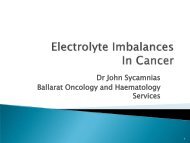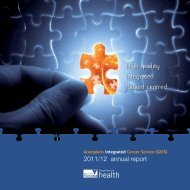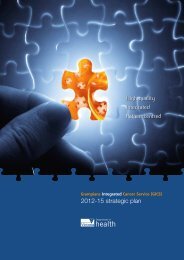Febrile Neutropenia
Febrile Neutropenia
Febrile Neutropenia
You also want an ePaper? Increase the reach of your titles
YUMPU automatically turns print PDFs into web optimized ePapers that Google loves.
<strong>Febrile</strong> <strong>Neutropenia</strong><br />
An ‘A–Z’ of the causes,<br />
incidence, symptoms, treatment and<br />
impact in patients with cancer<br />
Carmel O’Kane<br />
Oncology Nurse Practitioner Candidate,<br />
WHCG;SRH;EGHS
<strong>Neutropenia</strong><br />
Facts<br />
<strong>Neutropenia</strong> (reduced neutrophil count) is the most common<br />
dose-limiting toxicity of chemotherapy<br />
Falling neutrophil count is asymptomatic<br />
Symptoms are associated with neutropenic complication (e.g.<br />
infection, which leads to fever)<br />
<strong>Febrile</strong> neutropenia (FN) is life-threatening and requires urgent<br />
attention
Grading neutropenia<br />
<br />
<br />
<br />
!)<br />
* + <br />
< <br />
<br />
< <br />
<br />
< <br />
<br />
< <br />
<br />
!"##$%# &'( (<br />
),)-)!./
Highest risk of infection is during<br />
the nadir period<br />
!)0 + 1<br />
<br />
<br />
<br />
<br />
<br />
<br />
<br />
<br />
<br />
5$# !)$ <br />
#$ $4"#(" <br />
23 4"$"%($4<br />
8%4$"<br />
$ <br />
($ <br />
" #"<br />
-($" $4<br />
6'7"$" %"$
Clinical presentation of infection<br />
in patients with neutropenia<br />
<strong>Neutropenia</strong><br />
No signs<br />
Subtle changes<br />
• fatigue<br />
• respiratory<br />
• mucous<br />
membranes<br />
• urinary tract<br />
• nervous system<br />
Chills, sweats and<br />
fever<br />
<strong>Febrile</strong> neutropenic episode
Impact of neutropenia/infection<br />
Clinical outcomes<br />
dose delays and<br />
reductions- which is<br />
shown to reduce life<br />
expectancy<br />
IV antibiotics- can<br />
lead to resistance and super<br />
bugs etc<br />
infection<br />
treatment-related<br />
death-curative patients<br />
dying from toxicityunacceptable<br />
QOL<br />
hospitalisation-(often<br />
poor venous access- can<br />
define choice regarding<br />
further treatment)<br />
hospital<br />
acquired infection<br />
social isolation<br />
feeling unwell<br />
fatigue<br />
stress<br />
Economic<br />
hospitalisation<br />
costs<br />
costs of additional<br />
care<br />
ability to work<br />
# &69
Impact on chemotherapy<br />
delivery:<br />
Dose delays and reductions<br />
Dose reductions of ≥ 15% in<br />
40%<br />
of patients<br />
Dose delay of<br />
≥ 7 days in 24%<br />
of patients<br />
53% of patients received < 85% of the minimum 6-cycle<br />
treatment *<br />
<strong>Neutropenia</strong>: the leading cause of dose delays<br />
and reductions<br />
@$ " 85,+("("#<br />
4( &7
Delivering planned chemotherapy dose on<br />
time improves outcomes in early-stage breast<br />
cancer<br />
%"(<br />
" )*+<br />
,- !<br />
" )*<br />
. - !<br />
" )+<br />
<br />
<br />
≥ - !<br />
" )<br />
<br />
<br />
<br />
<br />
<br />
!"#$ "# <br />
$ !%&'<br />
!"!<br />
# ( %("%(4<br />
: ++
Summary<br />
<br />
<br />
<br />
<br />
<strong>Neutropenia</strong> is a common and serious complication of<br />
anti-cancer therapy:<br />
– infections may first be reported when they are already life-<br />
threatening, due to lack of symptoms<br />
– highest risk of infection is during the nadir period<br />
– Newer chemotherapeutic drugs are less predictable than older<br />
agents<br />
– duration and severity of neutropenia increase risk of FN<br />
<strong>Neutropenia</strong> is the most common reason for reduced<br />
and delayed chemotherapy<br />
FN is life-threatening<br />
<strong>Neutropenia</strong> and infection:<br />
– Reduce patient QoL<br />
– Increase cost of treatment and cost to society
Assessing risk and preventing<br />
neutropenic complications<br />
Identify high<br />
risk patients<br />
Employ<br />
preventive<br />
strategies<br />
Prevent FN<br />
Achieve full<br />
dose on time<br />
• G-CSF prophylaxis<br />
• Ongoing assessment<br />
• Education<br />
The<br />
obstacles<br />
- Guidelines identify<br />
high risk patients but<br />
are not always<br />
incorporated into<br />
clinical practice.<br />
'$$% <br />
#$%"7<br />
($% ( <br />
#"4.5 %# 4' C<br />
'7$ "<br />
( <br />
'""<br />
#"<br />
,A# <br />
"#B%<br />
<br />
$%%
Risk factors for FN<br />
Treatmentrelated<br />
risk<br />
Patient-related<br />
and other risks<br />
FN risk<br />
• High > 20%<br />
• Medium 10 20%<br />
• Low < 10%<br />
!$
Chemotherapy regimens with moderate<br />
to high risk of febrile neutropenia (FN)<br />
Regimen<br />
Risk of FN<br />
Breast cancer<br />
Paclitaxel AC > 20%<br />
Doxorubicin/Paclitaxel > 20%<br />
Docetaxel 10 – 20%<br />
Non-Hodgkin Lymphoma<br />
CHOP-21 > 20%<br />
CHOP-21 + R 10 – 20%<br />
Non-small cell lung cancer<br />
Docetaxel/Carboplatin > 20%<br />
Paclitaxel/Cisplatin 10 – 20%<br />
Ovarian cancer<br />
Docetaxel > 20%<br />
Topotecan 10 – 20%<br />
!$
Patient-related and other<br />
risk factors for FN<br />
Age > 65<br />
– Twice as likely to experience febrile neutropenia 1<br />
– Prophylactic G-CSF G<br />
should be used in all elderly<br />
patients receiving myelotoxic chemotherapy 2<br />
<br />
Other factors<br />
– Advanced disease stage<br />
– Previous episode of FN<br />
– Lack of G-CSF G<br />
use<br />
<br />
4( & 8$ & Aapro et al, 2006
Role of nurses in evaluating<br />
patient risk<br />
Assess the FN risk of planned<br />
chemotherapy regimen<br />
Evaluate presence of individual<br />
patient risk factors<br />
Evaluate overall risk<br />
!$
Granulocyte colony-stimulating factor<br />
(G-CSF) and neutrophil production<br />
Endogenous G-CSF<br />
324" 234" 34"<br />
Stem cells<br />
Neutrophil<br />
progenitors<br />
Precursor<br />
cells<br />
Post-mitotic<br />
cells<br />
Response is greater and<br />
more rapid than seen with<br />
endogenous<br />
G-CSF alone<br />
Therapeutic G-CSF<br />
4<br />
!$(% ( ++& +D+
G-CSF reduces FN incidence<br />
7%5'$1!"#$ $ $ !<br />
"8 "! "#'0<br />
-<br />
"# "<br />
! "#'0<br />
-<br />
-<br />
-<br />
-<br />
%"!/0%,1 +2 3<br />
' """!/0%,1 + 23<br />
%"!/0%,1 + 23<br />
-<br />
- -<br />
-<br />
-<br />
-<br />
'4 55! <br />
")6<br />
#5! <br />
")6+<br />
##<br />
")<br />
<br />
")<br />
%"!! "!!" <br />
!$(69 2<br />
<br />
69 2& )' & /
Side effects of G-CSFsG<br />
<br />
<br />
Mild/moderate medullary bone pain<br />
– most common side effect attributed to G-CSFsG<br />
– refer to individual product label for prevalence<br />
– successfully treated with mild analgesics<br />
Other side effects have been reported at varying levels<br />
and tend to be:<br />
– nausea, fatigue, alopecia, vomiting, headache<br />
– equally reported in placebo and treatment groups<br />
hence are probably associated with the chemotherapy<br />
itself<br />
A preventable death part 1
<strong>Febrile</strong> neutropenia<br />
Managing febrile neutropenic<br />
episodes in patients with cancer
Definition of <strong>Febrile</strong> neutropenia<br />
or Neutropenic fever<br />
<br />
! ($ # "DE)0DE) '<br />
%%""1#$%# "" *<br />
+%""" *+%"<br />
$% ' *+%"<br />
<br />
#$%"$""' ' #"<br />
(%(%4<br />
<br />
/"! "$ " "<br />
""!!<br />
"!
The impact of infection in<br />
patients with cancer<br />
Severe sepsis<br />
<br />
<br />
<br />
<br />
<br />
9.8% higher risk for sepsis than<br />
non-cancer patients<br />
Incidence higher in haematological<br />
malignancies<br />
Hospital mortality is higher<br />
Accounts for up to 10% of cancer<br />
deaths ( local data)<br />
Accounts for 4.9% of cancer<br />
hospitalisations but 14% of costs<br />
Implications for<br />
management of FN<br />
Implications for<br />
prevention of FN<br />
5 &F("
$ !<br />
SIRS<br />
Sepsis<br />
Systemic Inflammatory Response Syndrome<br />
(SIRS), the body’s response to a variety of<br />
severe clinical insults which may not be<br />
infection<br />
Systemic inflammatory response to infection<br />
<br />
"$""<br />
$%<br />
"%7<br />
Sepsis with acute organ dysfunction or<br />
hypoperfusion, or hypotension 1<br />
A subset of severe sepsis with hypotension<br />
despite adequate fluid resuscitation along<br />
with the presence of perfusion<br />
abnormalities that may include lactic<br />
acidosis, oliguria, or alteration of mental<br />
status 1<br />
<br />
5
Vital signs of SIRS<br />
<br />
Two or more of the following symptoms<br />
– Temperature > 38 o C or < 36 o C<br />
– Heart rate > 90 beats/min<br />
– Respiratory rate > 20 breaths/min or<br />
PaCO 2 < 32 mm Hg<br />
– WBC > 12 x 10 9 /L, < 4 x 10 9 /L or<br />
> 10% immature forms<br />
– Lowered blood pressure<br />
This will not delineate between SIRS and sepsis<br />
: ++2
Careful patient assessment is<br />
important<br />
<br />
Signs of infection are not always obvious<br />
– Temperature 38.3 °C C and ANC < 500 cells/mm 3 clearly<br />
indicate febrile neutropenia<br />
<br />
Some signs can indicate that patients should be checked and<br />
hospitalised:<br />
– Chills/shaking in bed<br />
– Feeling unwell/different (without clear explanation)<br />
– Changes in behaviour<br />
– Feeling faint/changes in skin tone<br />
Patients should be hospitalised as soon as possible<br />
"
Clinical pathway to manage<br />
neutropenic complications<br />
Determine and document patient’s history<br />
Take Full Blood film, Culture sputum, urine, all lumens of CVC,<br />
peripheral blood and other suspected sources of infection<br />
•Obtain a chest X-ray<br />
Administer empiric antibiotics, gram -ve and<br />
+ve, until source organism is identified<br />
Monitor blood culture reports daily<br />
@#"
Patient group<br />
Patients without features of systemic compromise<br />
(Beta-lactam monotherapy is recommended unless allergy to the<br />
recommended agent/s)<br />
Recommendation (grading and level of evidence)<br />
No penicillin allergy:<br />
Piperacillin-tazobactam 4.5 g IV 6–8 hourly (grade A) OR<br />
Cefepime 2 g IV 8 hourly<br />
Other reasonable choice for monotherapy is ceftazidime 2 g IV 8 hourly (grade<br />
A)<br />
Non-life threatening penicillin allergy (rash):<br />
Cefepime 2 g IV 8 hourly (grade C)<br />
Other reasonable choices for monotherapy are ceftazidime 2 g IV 8 hourly or<br />
meropenem 1 g IV 8 hourly (grade C)<br />
Life-threatening (immediate) penicillin allergy or beta-lactam allergy:<br />
Aztreonam 1-2 g IV 8 hourly OR ciprofloxacin 400 mg IV 12 hourly (expert<br />
opinion)<br />
+ vancomycin 1.5 g IV 12 hourly (if CrCl >90 mL/min) OR 1 g IV 12 hourly (if<br />
CrCl 60-90 mL/min)†*<br />
Patients with systemic compromise (The combination of a<br />
beta-lactam antibiotic with an aminoglycoside is the regimen of<br />
choice)<br />
Patients with cellulitis, obviously infected vascular devices, or<br />
MRSA carriers with extensive skin breaks/desquamation<br />
As for patients without features of systemic compromise (expert opinion)<br />
(see above):<br />
+ gentamicin 5 to 7 mg/kg ideal body weight IV once daily, adjusted to level<br />
+/– vancomycin 1.5 g IV 12 hourly (if CrCl >90 mL/min) OR 1 g IV 12 hourly (if<br />
CrCl 60-90 mL/min)†*<br />
As for patients without features of systemic compromise (see above):<br />
+ vancomycin 1.5 g IV 12 hourly (if CrCl >90 mL/min) OR 1 g IV 12 hourly (if<br />
CrCl 60-90 mL/min)†*<br />
Patients with features of abdominal or perineal infection<br />
As for patients without features of systemic compromise (see above):<br />
+ metronidazole 500 mg IV/PO 12 hourly if receiving cefepime, ceftazidime or<br />
ciprofloxacin first-line (grade D)<br />
Alternatively, piperacillin-tazobactam or meropenem will provide adequate<br />
anaerobic cover, if required (grade B) other than for suspected or proven<br />
Clostridium difficile-associated diarrhoea or colitis
The goal is to minimise risk of<br />
infections and complications<br />
<br />
<br />
<br />
<br />
<br />
Increase vigilance<br />
Intervene to eliminate risk factors<br />
Correct preparation of invasive procedures<br />
Minimise exposure to infection and bacteria<br />
– Hand hygiene<br />
– Protective isolation is not considered necessary<br />
however protection from the general population in an<br />
ED setting is preferred.<br />
Educate patients and their families about how to minimise<br />
their risk<br />
547'%9)!& $G'''B*%#7"(
Minimising exposure to<br />
infection and bacteria<br />
<br />
<br />
Hand washing 1<br />
– Use alcohol wash<br />
– Use correct hand washing protocol<br />
– Educate patients about hand washing<br />
Protective isolation<br />
Protective isolation is costly, is psychologically distressing for<br />
patients, and remains controversial 3<br />
– Consider Low bacterial diet<br />
– HEPA-filtered rooms or LAF rooms filter bacteria from the<br />
air 2-<br />
– Restrict visitors<br />
<br />
& @#($4" & 7
Patient and family education:<br />
Focus on prevention/reduction<br />
<br />
Nurses play a key role in educating patients and their families<br />
about neutropenia and FN<br />
<br />
Patients need to know<br />
– How to avoid infection<br />
– How to monitor for and report infection<br />
– When to seek medical care<br />
– How to balance family life with reducing risk<br />
))< #"=#$&"
A preventable death<br />
Part 2
Summary<br />
<br />
<br />
<br />
<br />
<strong>Febrile</strong> <strong>Neutropenia</strong> is a medical emergency<br />
<strong>Febrile</strong> neutropenia has a significant impact on morbidity and mortality<br />
Treating febrile neutropenia is associated with high healthcare costs<br />
!$%#"" 4"<br />
3 #% $ " ((" "7%<br />
3 ' """4($("#$<br />
<br />
<br />
<br />
Management of febrile neutropenia requires<br />
– Continuous monitoring<br />
– The prompt removal of the source of infection<br />
Local antimicrobial strategies will apply<br />
Effective hand washing is the most important intervention









